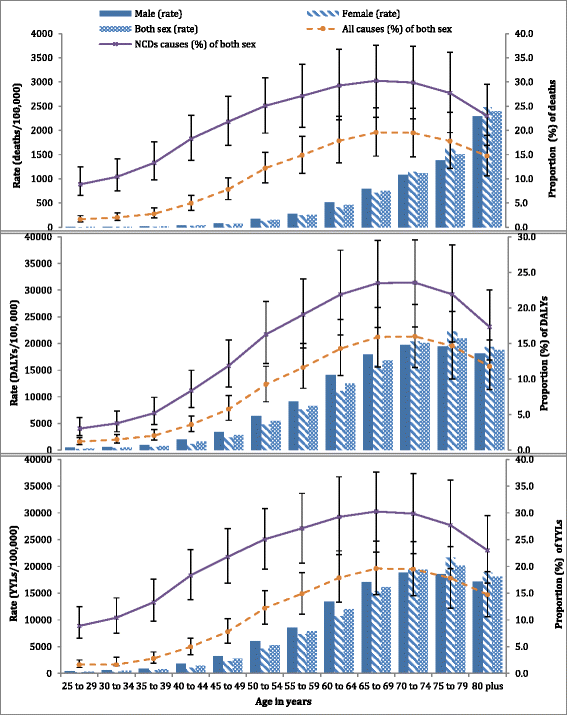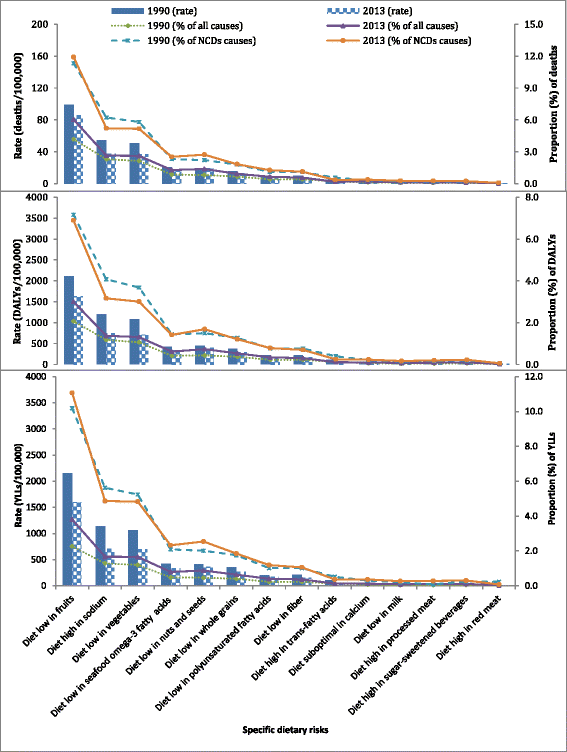The impact of dietary risk factors on the burden of non-communicable diseases in Ethiopia: findings from the Global Burden of Disease study 2013
- PMID: 27978839
- PMCID: PMC5159959
- DOI: 10.1186/s12966-016-0447-x
The impact of dietary risk factors on the burden of non-communicable diseases in Ethiopia: findings from the Global Burden of Disease study 2013
Abstract
Background: The burden of non-communicable diseases (NCDs) has increased in sub-Saharan countries, including Ethiopia. The contribution of dietary behaviours to the NCD burden in Ethiopia has not been evaluated. This study, therefore, aimed to assess diet-related burden of disease in Ethiopia between 1990 and 2013.
Method: We used the 2013 Global Burden of Disease (GBD) data to estimate deaths, years of life lost (YLLs) and disability-adjusted life years (DALYs) related to eight food types, five nutrients and fibre intake. Dietary exposure was estimated using a Bayesian hierarchical meta-regression. The effect size of each diet-disease pair was obtained based on meta-analyses of prospective observational studies and randomized controlled trials. A comparative risk assessment approach was used to quantify the proportion of NCD burden associated with dietary risk factors.
Results: In 2013, dietary factors were responsible for 60,402 deaths (95% Uncertainty Interval [UI]: 44,943-74,898) in Ethiopia-almost a quarter (23.0%) of all NCD deaths. Nearly nine in every ten diet-related deaths (88.0%) were from cardiovascular diseases (CVD) and 44.0% of all CVD deaths were related to poor diet. Suboptimal diet accounted for 1,353,407 DALYs (95% UI: 1,010,433-1,672,828) and 1,291,703 YLLs (95% UI: 961,915-1,599,985). Low intake of fruits and vegetables and high intake of sodium were the most important dietary factors. The proportion of NCD deaths associated with low fruit consumption slightly increased (11.3% in 1990 and 11.9% in 2013). In these years, the rate of burden of disease related to poor diet slightly decreased; however, their contribution to NCDs remained stable.
Conclusions: Dietary behaviour contributes significantly to the NCD burden in Ethiopia. Intakes of diet low in fruits and vegetables and high in sodium are the leading dietary risks. To effectively mitigate the oncoming NCD burden in Ethiopia, multisectoral interventions are required; and nutrition policies and dietary guidelines should be developed.
Keywords: Burden of disease; Dietary risks; Ethiopia; Non-communicable diseases.
Figures


Similar articles
-
Burden of disease attributable to suboptimal diet, metabolic risks and low physical activity in Ethiopia and comparison with Eastern sub-Saharan African countries, 1990-2015: findings from the Global Burden of Disease Study 2015.BMC Public Health. 2018 Apr 25;18(1):552. doi: 10.1186/s12889-018-5438-1. BMC Public Health. 2018. PMID: 29699588 Free PMC article.
-
Trends of mortality attributable to child and maternal undernutrition, overweight/obesity and dietary risk factors of non-communicable diseases in sub-Saharan Africa, 1990-2015: findings from the Global Burden of Disease Study 2015.Public Health Nutr. 2019 Apr;22(5):827-840. doi: 10.1017/S1368980018002975. Epub 2018 Dec 4. Public Health Nutr. 2019. PMID: 30509334 Free PMC article.
-
Burden and trend of diet-related non-communicable diseases in Australia and comparison with 34 OECD countries, 1990-2015: findings from the Global Burden of Disease Study 2015.Eur J Nutr. 2019 Apr;58(3):1299-1313. doi: 10.1007/s00394-018-1656-7. Epub 2018 Mar 7. Eur J Nutr. 2019. PMID: 29516222
-
Global, regional, and national burden of 12 mental disorders in 204 countries and territories, 1990-2019: a systematic analysis for the Global Burden of Disease Study 2019.Lancet Psychiatry. 2022 Feb;9(2):137-150. doi: 10.1016/S2215-0366(21)00395-3. Epub 2022 Jan 10. Lancet Psychiatry. 2022. PMID: 35026139 Free PMC article.
-
Alcohol use and burden for 195 countries and territories, 1990-2016: a systematic analysis for the Global Burden of Disease Study 2016.Lancet. 2018 Sep 22;392(10152):1015-1035. doi: 10.1016/S0140-6736(18)31310-2. Epub 2018 Aug 23. Lancet. 2018. PMID: 30146330 Free PMC article. Review.
Cited by
-
Diabetes mellitus and chronic kidney disease in the Eastern Mediterranean Region: findings from the Global Burden of Disease 2015 study.Int J Public Health. 2018 May;63(Suppl 1):177-186. doi: 10.1007/s00038-017-1014-1. Epub 2017 Aug 3. Int J Public Health. 2018. PMID: 28776240 Free PMC article.
-
The burden and trends of child and maternal malnutrition across the regions in Ethiopia, 1990-2019: The Global Burden of Disease Study 2019.PLOS Glob Public Health. 2024 Jul 16;4(7):e0002640. doi: 10.1371/journal.pgph.0002640. eCollection 2024. PLOS Glob Public Health. 2024. PMID: 39012910 Free PMC article.
-
The Global Diet Quality Score is Associated with Higher Nutrient Adequacy, Midupper Arm Circumference, Venous Hemoglobin, and Serum Folate Among Urban and Rural Ethiopian Adults.J Nutr. 2021 Oct 23;151(12 Suppl 2):130S-142S. doi: 10.1093/jn/nxab264. J Nutr. 2021. PMID: 34689198 Free PMC article.
-
Development and validation of food frequency questionnaire for food and nutrient intakes of adults in Butajira, Southern Ethiopia.J Nutr Sci. 2021 Nov 22;10:e98. doi: 10.1017/jns.2021.94. eCollection 2021. J Nutr Sci. 2021. PMID: 34888036 Free PMC article.
-
Methodology for developing and evaluating food-based dietary guidelines and a Healthy Eating Index for Ethiopia: a study protocol.BMJ Open. 2019 Jul 16;9(7):e027846. doi: 10.1136/bmjopen-2018-027846. BMJ Open. 2019. PMID: 31315863 Free PMC article.
References
-
- Murray CJ, Ortblad KF, Guinovart C, Lim SS, Wolock TM, Roberts DA, Dansereau EA, Graetz N, Barber RM, Brown JC, et al. Global, regional, and national incidence and mortality for HIV, tuberculosis, and malaria during 1990-2013: a systematic analysis for the Global Burden of Disease Study 2013. Lancet. 2014;384:1005–1070. doi: 10.1016/S0140-6736(14)60844-8. - DOI - PMC - PubMed
-
- Murray CJL, Barber RM, Foreman KJ, Ozgoren AA, Abd-Allah F, Abera SF, Aboyans V, Abraham JP, Abubakar I, Abu-Raddad LJ, et al. Global, regional, and national disability-adjusted life years (DALYs) for 306 diseases and injuries and healthy life expectancy (HALE) for 188 countries, 1990–2013: quantifying the epidemiological transition. Lancet. 2015;386:2145–91. doi: 10.1016/S0140-6736(15)61340-X. - DOI - PMC - PubMed
-
- Vos T, Barber RM, Bell B, Bertozzi-Villa A, Biryukov S, Bolliger I, Charlson F, Davis A, Degenhardt L, Dicker D, et al. Global, regional, and national incidence, prevalence, and years lived with disability for 301 acute and chronic diseases and injuries in 188 countries, 1990–2013: a systematic analysis for the Global Burden of Disease Study. Lancet. 2013;386:743–800. - PMC - PubMed
-
- Institute for Health Metrics and Evaluation (IHME). GBD Compare. Seattle, WA: IHME, University of Washington, 2015. Available from http://vizhub.healthdata.org/gbd-compare. Accessed 20 Feb 2016.
MeSH terms
Grants and funding
LinkOut - more resources
Full Text Sources
Other Literature Sources
Medical

